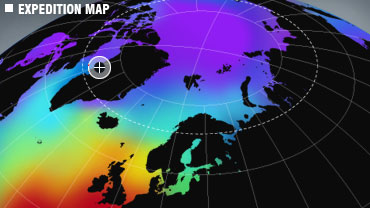Perdlerfiup Kangerdlua is a remote fjord at about 710 North and two glaciers discharge into its Y shaped end. The smaller of the two has retreated about 2 kilometres recently leaving a beach with a shallow foreshore. The larger still maintains a 100 metres high 3km wide calving face to the water, beyond which we can see the land based part of the glacier perhaps 500 metes above the fjord. It’s an amazing sight but always at the back of the mind is the possibility that the glacier may calve any second, sending out a very dangerous tsunami. Such an event left 20 people injured on one of the sister ships of the Grigory Mikheev last year and we maintain a respectful distance staying at right angles to the face as far as possible.
The scientists want to measure the salinity and temperate at various points in the fjord, which data will help track advancing climate change. I join them in a zodiac with Quentin Cooper who is making a BBC Radio 4 documentary about the expedition. The readings appear to be anomalous but might be explained by the cycle of calvings, which reduces salinity because glacier melt-water is fresh. While Dr Simon Boxall and Emily Venables are taking readings as near the glacier as they judge to be prudent, we hear a loud crack and the work is quickly completed. But there is no calving.
Read on at The Architect’s Journal website.



